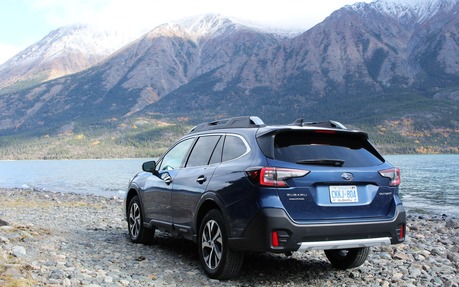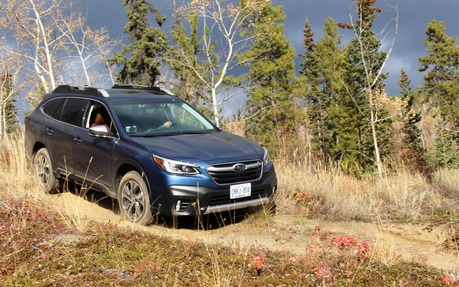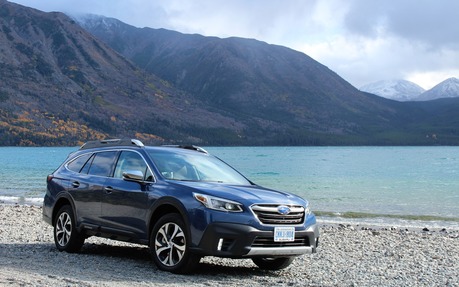2020 Subaru Outback: For a Real Active Lifestyle
WHITEHORSE, Yukon – We’ve been to countless media drives over the years, and with the SUV craze came the notion that every one of them was designed and engineered for consumers who enjoy an active lifestyle.
That means folks who spend their weekends outdoors. They go camping, hiking, cycling, kayaking and snowboarding, among other things, and need a vehicle that will not only haul their gear, but that looks rugged and adventurous, too. That perfectly defines the Subaru Outback ever since it was introduced some 25 years ago.
The Outback is essentially a high-riding station wagon, but it’s now classified as a light-duty truck in Canada and in the United States. It now rides on the same modular platform as all other Subaru models except the BRZ and the WRX sports cars, and shares many mechanical components with the equally new 2020 Subaru Legacy.
The brand showed us a few sketches with fresh design ideas for the Outback, but ultimately listened to customer feedback and chose an evolutionary reskin rather than a revolutionary one. That was a good move.
The conservatively styled sheetmetal of the 2020 Subaru Outback is wrapped in aggressive lower-body cladding and unpainted bumpers, crowned by raised roof rails that include swing-out crossbars. This thing is ready for carrying kayaks and bikes right out of the box. For 2020, even the Premier trim level now includes the bigger roof rack ensemble because customers asked for it.

The 2020 Subaru Outback is big and roomy, but still drives offers a car-like ride despite its jacked-up suspension. Its midsize shell allows for plenty of space up front and in the rear seat, whose backrest angle can be adjusted for increased comfort. The optional power tailgate is quicker than before and opens by itself if we’re standing close to it with the keyfob in our pocket.
Cargo space is up, but Subaru’s published numbers are down because of a revised SAE measurement standard. With the seatbacks in place, volume increases from 1,005 to 1,051 litres based on the previous standard, and with the seats folded, the cargo area grows from 2,075 to 2,209 litres. For the record, the new and revised numbers are 920 (seats up) and 2,144 litres (seats down). That’s as much as in many midsize, five-passenger SUVs.
The Outback’s interior design is also an evolutionary step up, with good quality materials and a solid switchgear feel. However, there’s not enough storage space on the centre console to dump gloves and snacks during the drive.
The big news here is that the infotainment system in the base trim level includes dual seven-inch screens—with audio and navigation info on the top one, climate control and vehicle functions on the bottom one. There are still some physical buttons, like the all-important volume dial in addition to temperature and defrost settings.
All other trims get a single touchscreen, but it measures 11.6 inches and is mounted vertically on the centre stack, à la Tesla and Volvo. Our test cars included the bigger screen, and it works well with good-sized button zones and a simple menu layout. Alternately, Apple CarPlay and Android Auto integration is standard on all trims. Wireless phone charging isn’t a factory option; we must buy an accessory kit and get it installed at the dealer, which costs $444 before taxes and labour.

Subaru STARLINK Connected Services is also new to the Outback. Offered with a free three-year subscription, STARLINK includes features such as remote vehicle start as well as lock and unlock, stolen vehicle locator and immobiliser, speed alert, curfew alert, boundary alert, online service appointment scheduling and enhanced roadside assistance. In the event of a crash, the system will automatically notify emergency services.
As before, a horizontally opposed, 2.5-litre four-cylinder engine is found under the hood of the 2020 Subaru Outback. However, it gets direct injection, automatic start/stop and most of its parts are new. It produces 182 horsepower and 176 pound-feet of torque. A continuously variable automatic transmission and a full-time all-wheel drivetrain are also included.
The 2.5-litre engine is smooth and powerful enough, although full-throttle acceleration isn’t exactly breathtaking. On the other hand, it’s rated at 9.0/7.1 L/100 km city/highway, which is actually very good—better in fact than in many compact AWD SUVs.
A 3.6-litre six was previously available in the Outback, but it’s been shelved in favour of a turbocharged 2.4-litre four-cylinder engine. It’s the same one that’s found in the Subaru Ascent and the new Legacy, and it develops 260 horsepower as well as 277 pound-feet of torque. It too is managed by a CVT. By the way, the latter has been reworked, with 80% new parts and a wider ratio range for improved performance and fuel economy. It does indeed work well with both engines.
According to Subaru, the turbocharged Outback XT can hit 100 km/h from a standstill in 6.4 seconds, while the outgoing generation with the six-cylinder mill reached the same velocity in 7.2. It’s no hot rod, but the XT is obviously more satisfying overall, and better suited to certain driving conditions—especially if we frequently load up the vehicle with people and their gear. The turbo Outback’s city/highway numbers are set at 10.1/7.9 L/100 km, so the sacrifice at the pump is small, and the engine runs fine on regular fuel. It also allows the Outback to boast a 3,500-lb (1,588-kg) towing capacity—compared to 2,700 lbs. (1,225 kg) for the base engine.

On the light off-road course Subaru had prepped for us, the Outback obviously performed flawlessly. The course wasn’t very challenging and any all-wheel drive SUV would’ve gotten through it with more or less effort, but it was a good opportunity to test the Subaru’s X-Mode, which includes hill decent control. The Outback slowly but surely made its way down the steep hill without us touching the brakes, occasionally lifting a wheel of showing off the rigidity of its new platform.
Pricing starts at $30,695 before freight and delivery charges for the Convenience trim level, which includes heated front seats, climate control, a power driver’s seat, cloth upholstery and the Subaru EyeSight advanced safety suite. The $34,795, value-packed Touring variant adds 17-inch alloy wheels, a power sunroof, the bigger infotainment screen with STARLINK services, blind spot monitoring and more. However, we would’ve liked a heated steering wheel at this price point—a feature reserved to posher trim levels.
New this year is the $38,695 Outdoor XT trim, which gets the turbo engine, heated rear seats, a blackout exterior treatment, a full-size spare tire, a front-view camera and weatherproof seat upholstery that feels like thin, soft vinyl. The more-equipped and leather-lined Limited and Premier trims can be ordered with either engine, with a maximum MSRP of $43,795.
This places the 2020 Subaru Outback in a sweet spot between compact and midsize SUVs, with excellent capabilities, plenty of room and the rugged appearance people with an active lifestyle seem to love. Along with lower fuel consumption, more performance and improved features, the new Outback should undoubtedly continue to be a popular choice for Canadian consumers who don’t want a cookie-cutter SUV.
| Test drive report | |
| Test model | 2020 Subaru Outback |
|---|---|
| Trim level | Outdoor XT |
| Price range | $30,695 – $43,795 |
| Price as tested | 38 695 $ |
| Warranty (basic) | 3 years/60,000 km |
| Warranty (powertrain) | 5 years/100,000 km |
| Fuel economy (city/highway/observed) | 10,1 / 7,9 / N/A L/100km |
| Options | N/A |
| Competitive models | Chevrolet Blazer, Ford Edge, GMC Acadia, Honda Passport, Hyundai Santa Fe, Jeep Wrangler, Nissan Murano, Toyota 4Runner |
| Strong points |
|
| Weak points |
|
| Editor's rating | |
| Fuel economy | Pretty efficient compared to both compact and midsize SUVs. |
| Comfort | We like the higher ride height for ease of entry and the driving position, while the extra suspension travel softens the ride. |
| Performance | Sufficient with the base engine, more enjoyable with the turbo engine. |
| Infotainment | Plenty of features and the bigger touchscreen is easy to use. Standard Apple CarPlay/Android Auto is nice, too. |
| Driving | The Outback is tuned more for ride quality than dynamic driving. |
| Overall | A better Outback in almost every way. |
